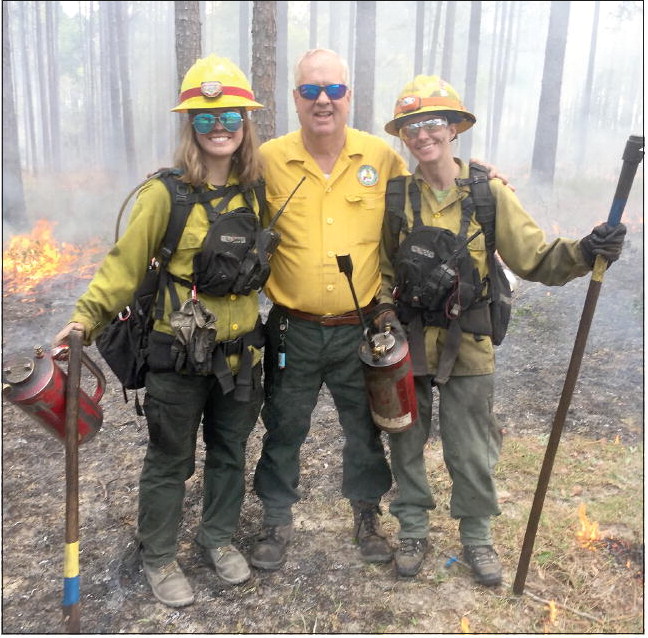continued from page Unlike ….


continued from page
Unlike a bear, a bobwhite quail is a warm, fuzzy creature that responds well to fire. Thompson traveled to Atlanta to the offices of the International Mascot Corporation, which has produced thousands of iconic fuzzy costumes for sports teams and companies. The result was the smiling, 8-foot, Burner Bob, a “cool dude with a hot message” that the forests need fire to survive. Burner Bob shows how to burn safely. (Burner Bob is a registered trademark and the “cool dude with a hot message” a registered slogan.)
The Burner Bob character accompanies Thompson and others to conservation events and fire festivals. The mascot is especially popular at school presentations. There are educational Burner Bob videos, cartoons, coloring books, and other materials geared to “spread the flame.” Though Thompson spent considerable funds on the mascot costume and collaterals, he licensed it for $1 to The Longleaf Alliance and makes no money off Bob.
“Bob helps educate children that not all fire is bad and that it needs to be conducted by experienced people in favorable conditions when permitted,” Thompson says. “You have to start with the children to start turning the ship of perception around, but it’s a long process.”
Thompson has conducted a similar public relations campaign for the indigo snake, though without the fuzzy costume, and geared more toward addressing the inconsistencies in endangered species listings. The muscular, blue-black, non-venomous snake, the longest native North American species at eight-plus feet, eats rattlesnakes and cottonmouths. The U.S. Fish and Wildlife Service listed the indigo snake as a threatened species in 1978.
Thompson notes that despite the indigo snake listing, there’s never been logging restrictions, unlike the policy surrounding the black pine snake. He’s addressed it with the USFWS.
“I’d never meet anyone from Fish and Wildlife until 15 years ago; I thought of them as cousins of the IRS,” Thompson said. “Now I have a lot of good friends there. But I told them, ‘You dropped the ball on the black pine snake.’ We’re blessed with indigo snakes, log around them, and nobody has ever said, ‘You can’t do this’ because you have indigo snakes, even though it’s been federally listed since 1978. It’s a double standard, and I don’t know what Fish and Wildlife’s motive was with the black pine snake.”
As head of FLA, Jones notes that such government bureaucracy and inconsistent application of endangered species policy is why many landowners understandably shy away from talking about endangered species on their land. Thompson, meanwhile, creates public relations campaigns about threatened species such as indigo snakes, gopher tortoises, and spotted turtles co-existing within best-practices forest management.
“Reese has not been afraid to talk about what’s on his property,” Jones says. “He doesn’t manage in fear of what might happen. He’s proactive when he says, ‘I think we can manage with these things and make them a value-add to the property.’ He can strike a balance between having regulated species and not having adverse relationships with regulators.”
Owen, the Virginia longleaf grower, calls Thompson a “practical conservationist” who walks the line between ecosystem and forest business. “Reese is committed to the mission of protecting, enhancing, and restoring the longleaf ecosystem entrusted to him while maintaining a solid investment in forestry and forest products for the future,” Owen says.
Jones says he can envision a time when the government and private businesses will provide credits to landowners for managing for endangered species, not unlike mitigation or carbon credits. “Land might become more valuable the more those species use it,” Jones said. “Reese could prove to be ahead of his time.”
Thompson says he wants to improve that future in other ways. He enjoys planting bald cypress in wet areas, knowing that someone will stumble upon them 50 years from now and know that someone planted it.
“Owning land is a discipline that keeps me grounded,” he says. “Continuing to add to the footprint keeps me working and prevents me from being tempted by detrimental activities. My mission is to protect, restore, and enhance what has been entrusted to me while serving as a good role model for the next generation.”
Pete Williams is the editor of Forest Landowner magazine, official publication of the Forest Landowners Association. For membership information, please visit forestlandowners.com.

PROFITABLE INVESTMENT – Well-managed longleaf pines like Thompson’s can becomea lucrative pine straw operation.








